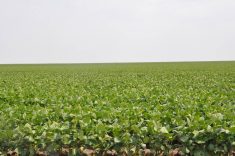The weather outlook appears challenging for the world’s largest exporter of corn and soybeans, which has ramifications for the entire grains and oilseeds complex.
It is already much drier than normal in central and northeastern Brazil and the forecast calls for more of the same.
A probability forecast prepared by the Columbia Climate School International Research Institute for Climate and Society shows a 45 to 60 percent chance of below normal precipitation for that area for the critical November-through-January period.
Read Also

Fertilizer method’s link to emissions studied
A researcher says others studying greenhouse gas emissions aren’t considering how the loss of nitrogen into the atmosphere correlates with fertilizer application or if there is an impact to yield.
The dry area includes eastern Mato Grosso, a state that accounts for 27 percent of Brazil’s soybean production.
The outlook does not bode well for Brazil’s soybean crop, which is currently being planted. But it is an even bigger threat for the corn crop that will follow, according to analysts.
“The corn crop really relies on the stored soil moisture to get through its season,” said DTN lead analyst Todd Hultman.
“We see this as a risk more to the second corn crop than we do the soybean crop the way things are setting up right now.”
That view is shared by Michael Cordonnier, analyst with the Soybean and Corn Advisor newsletter.
“It is much worse for safrinha corn,” he said.
That is Brazil’s second crop of corn, which is planted on the heels of the soybean harvest. It accounts for 75 percent of the country’s total production.
It now appears that the safrinha corn will be late getting in the ground because of the delayed soybean planting. Any corn planted after February will have reduced yields.
Cordonnier just lowered his corn estimate by two million tonnes to 123 million tonnes. That is well below the United States Department of Agriculture’s forecast of 129 million tonnes.
But both estimates are way above Conab’s forecast of 119 million tonnes.
Cordonnier said Conab has close ties with Brazil’s national weather service and probably knows something other analysts do not.
He said this is the first of what he anticipates will be a series of reductions, which eventually could bring his forecast down to Conab’s number.
But he wants to wait and see what happens with soybean planting over the next couple of weeks.
Cordonnier also reduced his soybean number by two million tonnes to 160 million tonnes. That is identical to Conab’s estimate but below the USDA’s forecast of 163 million tonnes.
Current weather condition can be best described as two extremes. The central and northeast has been hot and dry, with temperatures exceeding 40 C on most days.
“I would say about 30 percent of the soybean acreage in Brazil are in this hot and dry area looking for more rain,” he said.
Some growers are already replanting their crops.
There has been some improvement in rainfall recently, but multiple forecasts are calling for a return to dry weather in the weeks and months ahead.
And there could be a premature end to the summer rainy season because of El Nino.
“So late-planted soybeans could have a problem on both ends, the front end and the back end,” said Cordonnier.
It has been the opposite problem in the south of the country, which has been “deluged by rains.”
Seeding in Rio Grande do Sul, which is the third biggest soybean producing state, is just three percent complete compared to the usual 18 percent for this time of year.
Hultman said he is not concerned about the soybean crop because it is grown during the rainy season.
“The average monthly (rainfall) total is so high that we can be below normal and still have plenty enough for a good soybean crop in early 2024,” he said.
But Cordonnier said all it takes is one week of dry weather during the December-January pod-filling period to reduce yields.
If Brazil has a short crop, China will turn to the U.S. for soybeans, boosting prices in that important market.
The other factor to consider is that Argentina’s crushers will run out of soybeans in December and the new crop won’t be available until March.
“Once the soybeans start coming online in Argentina, the crushers are going to be absolutely desperate for every soybean they can get,” said Cordonnier.
That is why he believes the soybean complex has better potential for a rally than corn. But if Brazil’s safrinha corn crop gets off to a rough start, then “all bets are off.”
Contact sean.pratt@producer.com
















